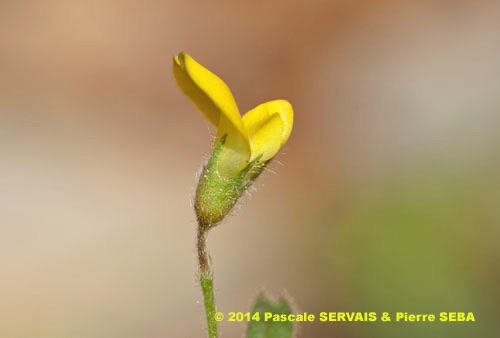
Medicago disciformis DC.
Fam. : Fabaceae
© Pascale SERVAIS & Pierre SEBA, 2018. Tilo Botanica: Flore de Tilos et du Dodécanèse / Flora of Tilos and of the Dodecanese
English translation by Brenda Bradbury, Howard Bradbury and Stéphane Léonard
Plante herbacée, hermaphrodite, étalée, rampante à prostrée, à tiges cylindriques, ramifiées, poilues, de 0,5 à 1 mm de diamètre.
Feuilles alternes, composées trifoliées, pétiolées, à folioles obovales, légèrement dentées au sommet, de 4 à 7 mm de long, de 3 à 6 mm de large, velues sur les 2 faces. Stipules lancéolées, dentées à la base, poilues.
Fleurs à symétrie bilatérale, jaune vif, de 4,5 à 7 mm de long, solitaires ou réunies à l’aisselle des feuilles par 2 à 4 (souvent 1 ou 2). Pédoncules plus longs que la feuille sous-jacente. Corolle papilionacée, à pétales dépassant nettement le calice, à ailes plus courtes que la carène, à carène plus courte que l’étendard. Calice à 5 sépales soudés, velus, terminés par une dent fine, à tube plus court que le pédicelle. Ovaire supère.
Fruits, gousses spiralées, vert brun à maturité, aplaties, lisses, luisantes, glabres mais à bords couverts de poils glanduleux, de 9 à 12 mm de diamètre (avec les épines), enroulées sur 5 à 7 spires superposées dans le sens des aiguilles d’une montre, sans trou central. Spires, sauf la dernière, avec des épines crochues, fines, douces, toutes rayonnantes et à l’extrémité dirigée vers le pédicelle. Graines oblongues, droites.
___________________________
Plant herbaceous, hermaphrodite, spread out, trailing to prostrate. Stems cylindrical, branched, hairy, from 0.5 to 1 mm in diameter.
Leaves alternate, compound trifoliate, petiolate, with obovate leaflets, slightly toothed at the top, from 4 to 7 mm long, 3 to 6 mm across, very hairy on the 2 faces. Stipules lanceolate, toothed at the base, hairy.
Flowers bilaterally symmetrical, bright yellow, from 4.5 to 7 mm long, solitary or joined together at the axil of the leaves by 2 to 4 (often 1 or 2). Peduncles longer than the underlying leaf. Corolla papilionaceous, with petals conspicuously exceeding the calyx, with wings shorter than the keel, with the keel shorter than the standard. Calyx with 5 fused sepals, very hairy, finished by a thin, tubular tooth shorter than the pedicel. Ovary superior.
Fruits, coiled pods, brown green at maturity, flattened, smooth, shiny, glabrous but with edges covered in glandulous hairs, from 9 to 12 mm in diameter (with the thorns), coiled clockwise on 5 to 7 superimposed whorls, without a central hole. Whorls, except the last, with hooked, thin, soft thorns, all spreading from the centre and with the tip directed towards the pedicel. Seeds oblong, straight.
Descripteurs / Identifying features
1
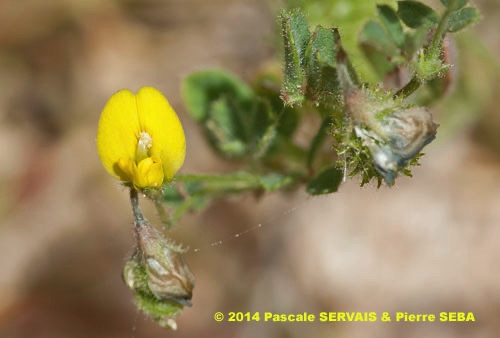
2
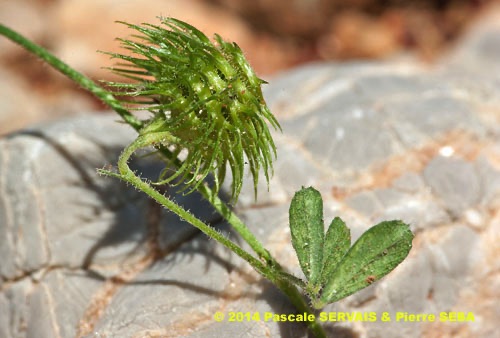
3
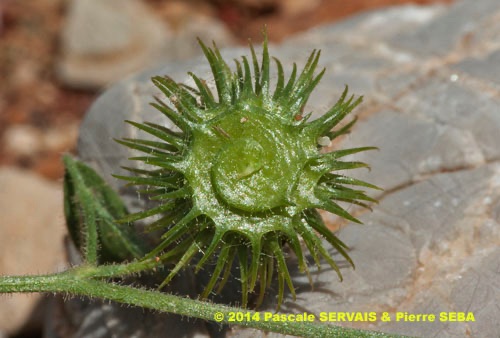
4
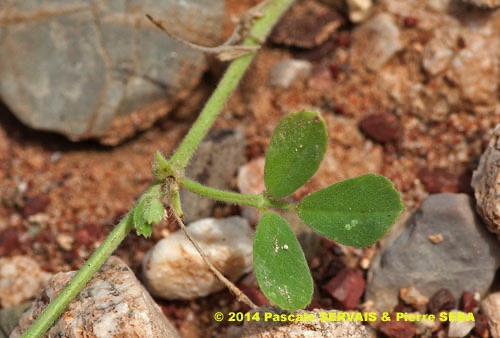
5
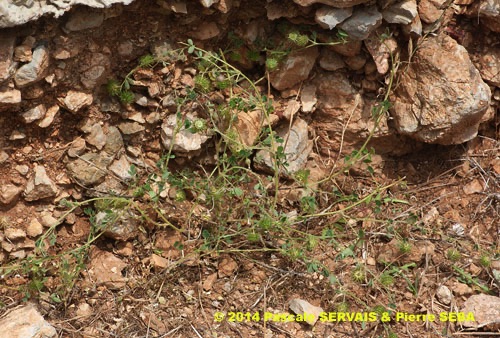
6
Étymologie / Etymology :
Medicago : emprunt du grec ancien μηδικός, -ή, -όν (adj.) = de Médie
(région de Perse), en référence au texte de Théophraste,
philosophe péripatéticien, disciple d’Aristote, botaniste et naturaliste,
mort vers 288 av. J.-C., qui croyait que la plante était originaire
de Perse.
Disciformis : adjectif créé par les botanistes [ < discus, -i (nom)
= le disque + forma, -ae (nom) = la forme ] = en forme de disque,
en référence à la forme des fruits.
Medicago : borrowed from Classical Greek μηδικός, -ή, -όν (adj)
= from Media (region of Persia), referring to the text of Theophrastus,
peripatetic philosopher, disciple of Aristotle, botanist and naturalist,
died towards 288 BC, who believed that the plant was native to Persia.
Disciformis : adjective created by botanists [ < discus, -i (noun)
= disc + forma, -ae (noun) = shape ] = disc-shaped, referring to
the shape of the fruits.
Synonyme / Synonym :
Medica disciformis (DC.) Bubani
Noms vernaculaires / Common names :
Nom français / French name :
Luzerne à fruits en disque.
Nom grec / Greek name :
Μηδική.
Nom anglais / English name :
Disk medick.
Noms allemands / German names :
Diskus-Schneckenklee — Scheibenförmiger Schneckenklee.
Nom espagnol / Spanish name :
Melgó disciforme.
Noms italiens / Italian names :
Erba medica con frutto a forma di disco — Erba medica disciforme.
Habitat :
Lieux pierreux - Lieux incultes - Chemins.
Stony places - Waste ground - Waysides.
Île / Island :
Tilos.
Hauteur / Height range :
De 5 cm à 20 cm.
From 5 cm to 20 cm.
Floraison / Flowering time :
De mars à juin.
From March to June.
Groupe / Classification :
Dicotylédones.
Dicotyledons.
Pérennité / Lifespan :
Annuelle.
Annual.
Description :
Clés dichotomiques et descripteurs distinctifs des 12 espèces / Dichotomous keys and distinctive identifying features of the 12 species
Photo 1 :
Localisation / Location : Tilos, Livadia, Aghios Stephanos
Date : 18/05/2014
GPS : Lat. 36,41035° N / Long. 27,40004° E / Alt. 6 m
Type : Photographie numérique / Digital Photograph (10 mégapixels)
Photo 2 :
Localisation / Location : Tilos, Livadia, Aghios Stephanos
Date : 18/05/2014
GPS : Lat. 36,41035° N / Long. 27,40004° E / Alt. 6 m
Type : Photographie numérique / Digital Photograph (10 mégapixels)
Photo 3 :
Localisation / Location : Tilos, Livadia, Aghios Stephanos
Date : 18/05/2014
GPS : Lat. 36,41035° N / Long. 27,40004° E / Alt. 6 m
Type : Photographie numérique / Digital Photograph (10 mégapixels)
Photo 4 :
Localisation / Location : Tilos, Livadia, Aghios Stephanos
Date : 18/05/2014
GPS : Lat. 36,41035° N / Long. 27,40004° E / Alt. 6 m
Type : Photographie numérique / Digital Photograph (10 mégapixels)
Photo 5 :
Localisation / Location : Tilos, Livadia, Aghios Stephanos
Date : 18/05/2014
GPS : Lat. 36,41035° N / Long. 27,40004° E / Alt. 6 m
Type : Photographie numérique / Digital Photograph (10 mégapixels)
Photo 6 :
Localisation / Location : Tilos, Livadia, Aghios Stephanos
Date : 18/05/2014
GPS : Lat. 36,41035° N / Long. 27,40004° E / Alt. 6 m
Type : Photographie numérique / Digital Photograph (10 mégapixels)

Google Maps
Google Maps
Google Maps
Google Maps
Google Maps
Google Maps